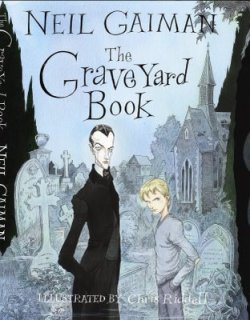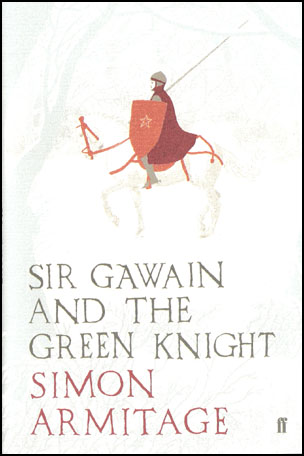The Graveyard Book – Neil Gaiman
 First off, congratulations to Mr. Gaiman for his (second, long-form) Hugo award for The Graveyard Book. A quick look at my Hall of Fame will leave the reader in no doubt about my regard for Neil’s work but, if pressed, I’d have to concede that his output since the brilliance of the Sandman has been uneven at best. I’ve read it all religiously of course and though each piece of work has something to remind us of Gaiman’s virtuosity, there’s always a flicker of disappointment that he hasn’t been able to repeat in prose, the god-like genius of his graphic novels. American Gods is about as close as he’s come and that, of course, won his first Hugo.
First off, congratulations to Mr. Gaiman for his (second, long-form) Hugo award for The Graveyard Book. A quick look at my Hall of Fame will leave the reader in no doubt about my regard for Neil’s work but, if pressed, I’d have to concede that his output since the brilliance of the Sandman has been uneven at best. I’ve read it all religiously of course and though each piece of work has something to remind us of Gaiman’s virtuosity, there’s always a flicker of disappointment that he hasn’t been able to repeat in prose, the god-like genius of his graphic novels. American Gods is about as close as he’s come and that, of course, won his first Hugo.
So I approached the Graveyard Book with mixed emotions: it’s Neil Gaiman, it won the Hugo, it was going to be good; but would it be good enough to convert the heathens? To tanscend the ghetto and find wider appeal across the literary world? To inspire others to discard their comic book preconceptions and actually read the Sandman? Given the Young Adult tag, the answer was probably: no, but even so, a treat in store surely for the observant faithful.
Aged two, Nobody Owens (Bod) narrowly escapes being murdered with the rest of his family, by the man Jack – a tall dark stranger with a long knife. At the critical moment, Bod wanders innocently into a nearby graveyard cum nature-reserve, where Mr and Mrs Owens (RIP) remove him from harm’s way. With the help of another tall dark stranger – a mysterious graveyard interloper called Silas, who’s neither alive nor dead – Mr and Mrs Owens persuade the rest of the graveyard’s inhabitants to allow them to adopt Bod. This presents immediate practical problems, as none of those souls buried in the graveyard can leave it, yet someone must provide regular food supplies. Silas offers to act as Bod’s guardian, as he can come and go as he pleases, and uses the graveyard as a base for his frequent visits into the wider world. With that settled, the stage is set for Bod’s unconventional upbringing; no proper school but plenty of time to explore the extensive grounds and befriend the eccentric residents, some of whom date back to Roman times and beyond. It goes without saying that on no account must Bod leave the safety of the graveyard, the man Jack is still out there and, it turns out, anxious to finish the job.
We are now deep in Gaiman territory: idiosyncratic but heart-in-the-right-place characters, a niave but determined protagonist and a Burton-esque gothic theme. Bod meets ghosts, ghouls, vampires, a witch, a werewolf, the mysterious Sleer who live in a crypt buried deep in the heart of the hill, and a real-live friend called Scarlett. Their influence on the story appears to be passing but the long-time Gaiman devotee just knows that they’ll play some clever and critical part later on, as the book reaches its conclusion. Gaiman is adept at breathing new life into gothic archetypes and folklore; I particularly liked the dance macabre, an irregular festival eagerly anticipated by the ghosts, as they are for one night, allowed to leave the graveyard and descend into town. Though the townsfolk don’t know why, they have made their own preparations for a night they will spend, literally, dancing with death, communing with their ancestors in a celebration of lives past and lives still being lived
The importance of living and celebrating life is the central theme of the Graveyard Book. To young Bod, the unchanging, predictable and safe lives of the dead – after all, what’s the worst that can happen? – must seem very attractive compared to living in constant fear of the man Jack and his big knife. But the dead don’t see it that way: being alive means you can change, not just yourself but the world around you; Bod can grow and learn and meet new friends. It’s a message to us all: in the midst of life we are in death, but it is this very knowledge which defines the lives we lead and gives us the reason to live them to their fullest. Silas in particular, goes to great lengths to protect Bod, as he understands this essential truth: while Bod lives, he can still bring about change; in the context of the story, the change will have implications for every man Jack of them.
As it turns out, Silas needn’t have worried. Bod has no intention of skulking in fear behind the safety of the cemetry gates and in one memorable passage explains that when it comes to the man Jack: ‘the question isn’t, “who’ll keep me safe from him?”… it’s “who will keep him safe from me?”‘ This takes us to the heart of Gaiman’s sucess as a teller of (fairy)tales, he finds fresh and radical ways to retell the archetypal stories; his protagonists aren’t impotent dolls, unquestioningly buffeted by events and stronger characters, they’re emancipated and unafraid to take control of their destinies. Another one of Gaiman’s divine powers is alchemy, his potions turn base elements into literary gold, bringing together themes, characters and traditional stories, adding a few secret ingredients of his own, cooking up a lyrical brew that is so much more than the sum of its parts. One puts the book down feeling enriched and uplifted, infused with a new sense of joie de vive.
The Graveyard Book has been marketed – rightly in my view – as a Young Adult title and while I would unhesitatingly recommend it to any young adults who ask, it’s a little linear, simplistic and short for me (a not so young adult). We learn little of Silas and the organisation to which he belongs, or indeed of any of the other characters beyond what is required by the plot. Whole worlds and themes are glimpsed tantalisingly on the peripherary but left undeveloped as we stay close to Bod. The objective reviewer in me can see that this is probably as it should be for a young adult novel, and judged on its own terms, it’s difficult to disagree with the Hugo award. But the highly subjective Gaiman fan in me, wishes greedily for more. And more.
Prophets have long foretold the second coming of Neil Gaiman as a writer of multi-layered prose novels as intriate, rich and rewarding as the Sandman. There are many latter-day nay-sayers, not least I suspect Neil Gaiman himself, who has said that he was a borderline workaholic during the late eighties / early nineties. The Graveyard Book has much to recommend it, particularly to its target audience, but it isn’t the holy book some of us have been anticipating all these years. True believer that I am though, I’ll continue to keep the faith.
No comments yet.






Leave a comment